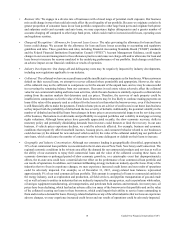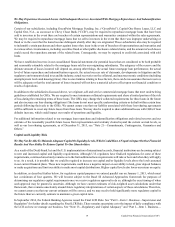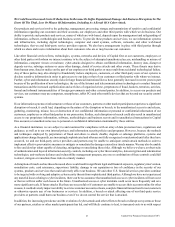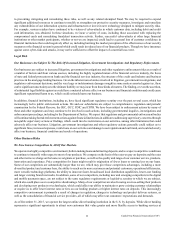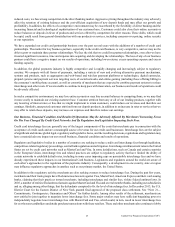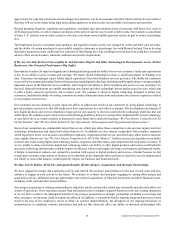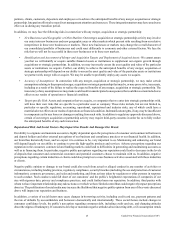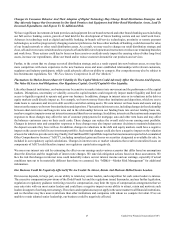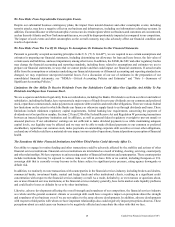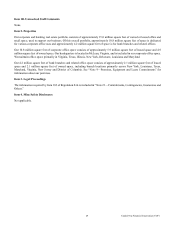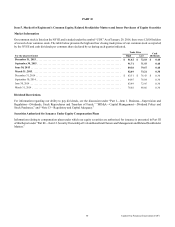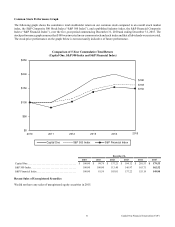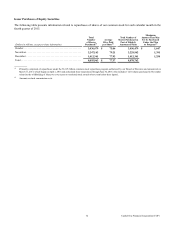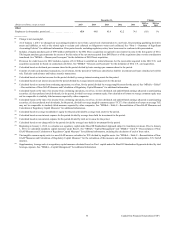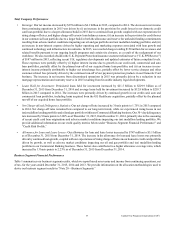Capital One 2015 Annual Report Download - page 46
Download and view the complete annual report
Please find page 46 of the 2015 Capital One annual report below. You can navigate through the pages in the report by either clicking on the pages listed below, or by using the keyword search tool below to find specific information within the annual report.27 Capital One Financial Corporation (COF)
Changes In Consumer Behavior And Their Adoption of Digital Technology May Change Retail Distribution Strategies And
May Adversely Impact Our Investments In Our Bank Premises And Equipment And Other Retail Distribution Assets, Lead To
Increased Expenditures And Expose Us To Additional Risk.
We have significant investments in bank premises and equipment for our branch network and other branch banking assets including
our full service banking centers, parcels of land held for the development of future banking centers and our retail work force.
Advances in technology such as digital and mobile banking, in-branch self-service technologies, proximity or remote payment
technologies, as well as progressively changing customer preferences for these other methods of banking, could decrease the value
of our branch network or other retail distribution assets. As a result, we may need to change our retail distribution strategy and
close, sell and/or renovate certain branches or parcels of land held for development and restructure or reduce our remaining branches
and work force. These actions could lead to losses on these assets or could adversely impact the carrying value of other long-lived
assets, increase our expenditures, dilute our brand and/or reduce customer demand for our products and services.
Further, to the extent that we change our retail distribution strategy and as a result expand into new business areas, we may face
more competitors with more experience in the new business areas and more established relationships with relevant customers,
regulators and industry participants, which could adversely affect our ability to compete. Our competitors may also be subject to
less burdensome regulations. See “We Face Intense Competition In All Our Markets.”
Fluctuations In Market Interest Rates Or Volatility In The Capital Markets Could Adversely Affect Our Income And Expense,
The Value Of Assets And Obligations, Our Regulatory Capital, Cost Of Capital Or Our Liquidity.
Like other financial institutions, our business may be sensitive to market interest rate movement and the performance of the capital
markets. Disruptions, uncertainty or volatility across the capital markets could negatively impact market liquidity and limit our
access to liquidity required to operate and grow our business. In addition, changes in interest rates or in valuations in the debt or
equity markets could directly impact us. For example, we borrow money from other institutions and depositors, which we use to
make loans to customers and invest in debt securities and other earning assets. We earn interest on these loans and assets and pay
interest on the money we borrow from institutions and depositors. Fluctuations in interest rates, including changes in the relationship
between short-term rates and long-term rates and in the relationship between our funding basis rate and our lending basis rate,
may have negative impacts on our net interest income and therefore our earnings. In addition, interest rate fluctuations and competitor
responses to those changes may affect the rate of customer prepayments for mortgage, auto and other term loans and may affect
the balances customers carry on their credit cards. These changes can reduce the overall yield on our earning asset portfolio.
Changes in interest rates and competitor responses to these changes may also impact customer decisions to maintain balances in
the deposit accounts they have with us. In addition, changes in valuations in the debt and equity markets could have a negative
impact on the assets we hold in our investment portfolio. Such market changes could also have a negative impact on the valuation
of assets for which we provide servicing. Finally, the Final Basel III Capital Rule requires that most amounts reported in Accumulated
Other Comprehensive Income (“AOCI”), including unrealized gains and losses on securities designated as available for sale, be
included in our regulatory capital calculations. Changes in interest rates or market valuations that result in unrealized losses on
components of AOCI could therefore impact our regulatory capital ratios negatively.
We assess our interest rate risk by estimating the effect on our earnings under various scenarios that differ based on assumptions
about the direction and the magnitude of interest rate changes. We take risk mitigation actions based on those assessments. We
face the risk that changes in interest rates could materially reduce our net interest income and our earnings, especially if actual
conditions turn out to be materially different than those we assumed. See “MD&A—Market Risk Management” for additional
information.
Our Business Could Be Negatively Affected If We Are Unable To Attract, Retain And Motivate Skilled Senior Leaders.
Our success depends, in large part, on our ability to retain key senior leaders, and competition for such senior leaders is intense.
The executive compensation provisions of the Dodd-Frank Act and the regulations issued thereunder, and any further legislation,
regulation or regulatory guidance restricting executive compensation, may limit the types of compensation arrangements that we
may enter into with our most senior leaders and could have a negative impact on our ability to attract, retain and motivate such
leaders in support of our long-term strategy. These laws and regulations may not apply in the same manner to all financial institutions,
and we therefore may face more restrictions than other institutions and companies with whom we compete for talent. If we are
unable to retain talented senior leadership, our business could be negatively affected.



